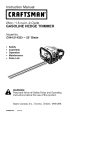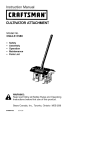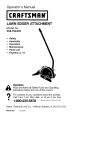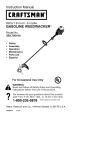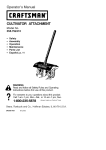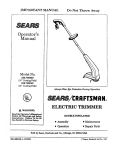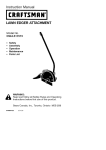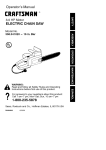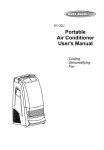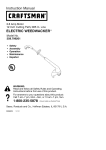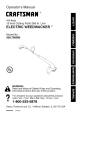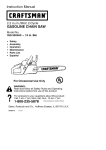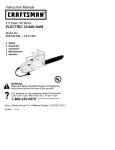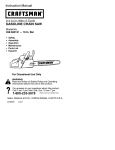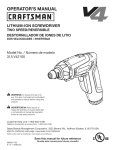Download Craftsman C944.514610 Instruction manual
Transcript
Instruction Manual J€:RAFTSMA#°J PRUNER A'I-rACHMENT Model No. C944.514610 • • Safety Assembly • • Operation Maintenance • Parts List WARNING: Read and follow all Safety Rules and Operating Instructions before first use of this product. Sears Canada, 545001437 1/17/05 Inc., Toronto, Ontario M5B 2B8 Warranty Statement Identification of Symbols Safety Rules Assembly Operation 2 2 2 7 9 Maintenance Service & Adjustments Storage Parts List Parts and Ordering 1 13 14 Center Section Back Cover LIMITED TWO (2) YEAR WARRANTY ON CRAFTSMAN ® PRUNER ATTACHMENT For two (2) years from tile date of purchase, Sears Canada, Inc., will repair or replace free of charge, at Sears option, parts which are defective as a result of material or workmanship. COMMERCIAL OR RENTAL USE: Warranty on Pruner Attachment will be 90 days from the date of purchase if used for commercial or rental purposes. This warranty excludes expendable parts that become worn during normal use. Warranty service is available by returning the Pruner Attachment to the nearest Sears Service Centre/Department in Canada. This warranty applies only while this product is in use in Canada. This warranty is in addition to any statutory warranty and does not exclude or limit legal rights you may have but shall run concurrently with applicable provincial legislation. Furthermore, some provinces do NOT allow limitations on how long an implied warranty will last, so the above limitations may not apply to you. Sears Canada, inc., Toronto, Ontario MSB 2B8 DANGER! Read and understand the instruction manuel before using the pruner. This pruner can be dangerous! Careless or improper use can cause serious or even fatal injury. Always wear appropriate DANGER! protection ear protection, eye protection Falling objects can cause severe when operating this unit. ,t% dt_WARNING: When using an electric pruner or any other electric gardening appliance, basic safety precautions must always be followed to reduce the risk of fire, electric shock, and serious injury. Read and follow all instructions. and head protection. head injury, Wear head Do not stand beneath branch being z't WARNING: Always disconnect spark plug wire and place wire where it cannot contact spark plug (or disconnect powerhead from power source) to prevent accidental starting when setting up, transporting, adjusting or making repairs except carburetor adjustments. 2 Because apruner isahigh-speed wood-cutting tool,special safety precautions must beobserved toreduce the riskofaccidents. Careless orimproper useofthistoolcancause serious or even fatalinjury. PLAN AHEAD • Read this manual carefully until you completely understand and can follow all safety rules, precautions, and operating instructions before attempting to use the unit. • Restrict the use of your pruner to adult users who understand and can follow safety rules, precautions, and operating instructions found on the unit and in this manual. INSTRUCTION SAFETY MANUAL ON THE '_ INFORMATION UNIT Protection Heavy Duty GIoves Safety Shoes 50 feet A SEfy etyHat Fitting Clothing ZONE i_1_..__. • Wear protective gear. Always use steel-toed safety footwear with nonslip soles; snug-fitting clothing; heavy, long pants, and long sleeves; heavyduty, non-slip gloves; eye protection such as non-fogging, vented goggles or face screen; an approved safety hard hat; and sound barriers (ear plugs or mufflers) to protect your hearing. Regular users should have hearing checked regularly as engine noise can damage hearing. Secure hair above shoulder length. Secure or remove loose clothing and jewelry or clothing with loosely hanging ties, straps, tassels, etc. Snug HAZARD ""-.ai. (15 meters) DANGER: Do not use near e_ectrical wires or power lines. Keep pruner at least 30 feet (10 meters) lines. away from all power • Do not handle or operate a pruner when you are fatigued, ill, or upset, or if you have taken alcohol, drugs, or medication. You must be in good physical condition and mentally alert. If you have any condition that might be aggravated by strenuous work, check with doctor before operating a pruner. • Carefully plan your pruning operation in advance. Do not start cutting until you have a clear work area, secure footing, and a planned retreat path. FUEL SAFETY (for gas powerheads) • Mix and pour fuel outdoors. • Keep away from sparks or flames. • Use a container approved for fuel. • Do not smoke or allow smoking near fuel or the powerhead. • Avoid spilling fuel or oil. Wipe up all fuel spills before starting the powerhead. • Move at least 10 feet (3 meters) away from fueling site before starting powerhead engine. • Stop engine and allow to cool before removing fuel cap. • Remove fuel cap slowly. ELECTRICAL powerheads) Safety Chaps _ SAFETY (for electric _'WARNING: Avoid a dangerous environment. To reduce the risk of electrical shock, do not use in rain, in damp or wet locations, or around swimming pools, hot tubs, etc. Do not expose to snow, rain, or water to avoid the possibility of electrical shock. Do not use on wet surfaces. Do not handle extension cord plug or unit with wet hands. • Use only a voltage supply as shown on the nameplate of the unit. • Keep all parts of your body away from the chain when the engine is running. • Keep children, bystanders, and animals a minimum of 50 feet (15 meters) away from the work area. Do not allow other people or animals to be near when starting or operating the pruner. 3 • Avoid dangerous situations. Donot sharp edges orcorners. Donotexuseinpresence offlammable liquids pose cords toheat, oil,orwater. orgases toavoid creating afireor • Keep theextension cordclear ofoperator andobstacles atalltimes. explosion and/or causing damage to unit. • Tiecordtocordretainer andcon• Avoid dangerous environments. necttorecessed plugasshown in notuse inunventilated areas orDo thismanual toprevent damage to unitand/or extension cordandtorewhere dustorexplosive vapors can buildup. ducethepossibility oftheextension • Toreduce theriskofelectric shock, corddisconnecting fromtheunitdurthepowerhead mayhave apolarized ingoperation. plug(one blade iswider than theoth- • Donotattempt torepair unit.Inspect theinsulation andconnectors onthe er);ifso,itwillrequire theuseofapolarized extension cord. Theappliance powerhead andextension cordbefore plugwillfitintoapolarized extension each use.Ifthere isanydamage, do cordonlyoneway. Iftheplugdoes notuseuntildamage isrepaired by notfitfullyintotheextension cord, reyourauthorized service dealer. verse theplug. Iftheplugstilldoes • Donotusethepowerhead ifthe switch does notturntheunitonand notfit,obtain acorrect polarized extension cord. Apolarized extension offproperly. Have theunitrepaired cordwillrequire theuseofapolarized byyourauthorized service dealer. walloutlet. Thisplugwillfitintothepo- • Donotusewithdamaged cordor larized walloutlet onlyoneway.Ifplug plug.Ifpowerhead isnotworking as does notfitfullyintothewalloutlet, itshould, hasbeen dropped, damreverse theplug. Ifitstilldoes notfit, aged, leftoutdoors, ordropped into contact aqualified electrician toinstall water, return ittoyourauthorized sertheproper walloutlet. Donotchange vicedealer forrepair. theequipment plug, extension cord • Avoid unintentional starting ofthe receptacle, orextension cordplugin unit.Never carry unitwithyourfinger ontheswitch. Besuretheswitch is anyway. • Toreduce riskofelectrical shock, use intheOFF position andnever touch extension cords specifically marked theswitch whenconnecting extensioncord. assuitable foroutdoor appliances having electrical rating notlessthan • Unplug theunitfromthepower source when notinuse,before servictherating ofunit.Cord must be marked withsuffix WV-A" (inCanada ing,andwhen changing accessories and/or attachments. WV"). Make sure yourextension cord isingood condition. Inspect extension• Avoid anybodycontact withany cordbefore useandreplace ifdamgrounded conductor, suchasmetal aged. Donotuseadamaged cord. fences, orpipes, toavoid thepossiCord insulation must beintact withno bilityofelectric shock. cracks ordeterioration. Plug connec- • Ground Fault Circuit Interrupter torsmust beundamaged. Theexten- (GFCI) protection should beprovidedonthecircuit oroutlet tobe sioncordused toreach thepower source must beheavy enough to used forthepowerhead. Recepcarry current fromthepower source tacles areavailable having built-in thefulllength oftheextension cordto GFCIprotection andmaybeused theunit. Anundersized extension forthismeasure ofsafety. cordwillcause adropinlinevoltage UNIT/MAINTENANCE SAFETY resulting inlossofpower andover,_WARNING: Disconnect powerheating. Ifindoubt, usethenext heavier gauge. Thelower thegauge head spark plug (or disconnect powernumber, theheavier thecord. head from power source) before per• Donotusemultiple cords. forming maintenance. • Donotabuse cord.Never carrythe • Inspect entire unit before each use. unitbytheextension cordoryank Replace damaged parts. Check for extension cordtodisconnect unit.To fuel leaks. Make sure all fasteners are unplug, grasp theplug, notthecord. in place and securely fastened. Donotusecordasahandle, close a • Maintain unit according to recomdooroncord, orpullcordaround mended procedures. • Useonlyrecommended CraftsmanCR_ Always replace bar and chain immediparts andaccessories. ately if it becomes damaged, broken or is otherwise removed. • Besurechain stopsmoving when engine idles(seeCARBURETOR AD- • Always stop the unit when work is JUSTMENT section ofpowerhead delayed or when walking from one manual). cutting location to another. Stop the • Keep others away whenmaking carengine before setting the unit down. buretor adjustments. • Use only in daylight or good artificial • Never starttheunitwiththeclutch light. housing removed. Theclutch canfly • Use only for jobs explained in this manual. offandcause serious injury. • Keep thehandles driy, clean, andfree KICKBACK ofoilorfuelmixture. A0&WARNING: Avoid kickback • Keep fuelandoilcaps, screws, and fasteners securely tightened. which can result in serious injury. • Have allmaintenance andservice not Kickback is the backward, upward or explained inthismanual performed by sudden forward motion of the guide aSears Service Center. bar occurring when the chain near the upper tip of the guide bar contacts any OPERATE YOUR PRUNER SAFELY • Do not operate a pruner with one hand. Serious injury to the operator, helpers, bystanders or any combination of these persons may result from one-handed operation. A pruner is intended for two-handed use. • Operate the pruner only in a well-ventilated outdoor area. • Do not operate pruner from a ladder or in a tree. • Do not use a pruner to cut down trees or any portion of the tree trunk. • Only use for pruning limbs or branches overhead not greater than 4 inches (10 cm) in diameter. • Never stand under the limb you are pruning. Always position yourself out of the path of falling debris. • Do not cut small brush and saplings with the pruner. Slender matter may catch in the chain and be whipped toward you, pulling you off balance. • Make sure the chain will not make contact with any object while starting the engine. Never try to start the unit when the guide bar is in a cut. • Do not put pressure on the pruner at the end of the cut. Applying pressure can cause you to lose control when the cut is completed. • Do not run the unit at high speed when not pruning. • If you strike or become entangled with a foreign object, stop the engine immediately and check for damage. Have any damage repaired by a Sears Service Center before attempting further operations. • Do not operate a pruner that is damaged, improperly adjusted, or not completely and securely assembled. object such as a log or branch, or when the wood closes in and pinches the chain in the cut. Contacting a foreign object in the wood can also result in loss of control. • Rotational Kickback can occur when the moving chain contacts an object at the upper tip of the guide bar. This contact can cause the chain to dig into the object, which stops the chain for an instant. The result is a lightning fast, reverse reaction which kicks the guide bar up and back toward the operator. • Pinch-Kickback can occur when the wood closes in and pinches the moving chain in the cut along the top of the guide bar and the chain is suddenly stopped. This sudden stopping of the chain results in a reversal of the chain force used to cut wood and causes the pruner to move in the opposite direction of the chain rotation. The pruner is driven straight back toward the operator. • Pull-In can occur when the moving chain contacts a foreign object in the wood in the cut along the bottom of the guide bar and the chain is suddenly stopped. This sudden stopping pulls the pruner forward and away from the operator and could easily cause the operator to lose control of the pruner. REDUCE THE CHANCE OF KICKBACK • Recognize that kickback can happen. With a basic understanding of kickback, you can reduce the element of surprise which contributes to accidents. • Never letthemoving chain contact anyobject atthetipoftheguide bar. • Keep theworking area freefromobstructions suchasother trees, branches, rocks, stumps, etc.Eliminateoravoid anyobstruction that yourchain could hitwhile youare cutting. When cutting abranch, do notlettheguide barcontact branch orother objects around it. • Keep yourchain sharp andproperly tensioned. Aloose ordullchain can increase thechance ofkickback occurring. Follow manufacturer's chain sharpening andmaintenance instructions. Check tension atregular intervalswiththeengine stopped, never withtheengine running. Make sure thebarclamp nutissecurely tightened after tensioning thechain. • Begin andcontinue cutting atfull speed. Ifthechain ismoving ata slower speed, thereisgreater chance ofkickback occurring. • Cutonebranch atatime. • Useextreme caution whenre-enteringa previous cut. • Donotattempt cutsstarting withthe tipofthebar(plunge cuts). • Watch forshifting ofwood orother forces thatcould close acutand pinch orfallintochain. • UsetheReduced-Kickback Guide BarandLow-Kickback Chain specifiedforyourunit. MAINTAIN CONTROL around the throttle handle whether your are right handed or left handed. • Stand with your weight evenly balanced on both feet. • Stand slightly to the left side of the pruner to keep your body from being in a direct line with the cutting chain. KICKBACK SAFETY FEATURES The following features are included on your pruner to help reduce the hazard of kickback; however, such features will not totally eliminate this danger. As a pruner user, do not rely only on safety devices. You must follow all safety precautions, instructions, and maintenance in this manual to help avoid kickback and other forces which can result in serious injury. • Reduced-Kickback Guide Bar, designed with a small radius tip which reduces the size of the kickback danger zone on the bar tip. Reduced Kickback Symmetrical Symmetrical Guide Bar Guide Bar l_ Large Radius Contoured Depth Gauge D Elongated Low-Kickback Chain / Tip • Low-Kickback Chain, designed with a contoured depth gauge and guard link which deflect kickback force and allow wood to gradually ride into the cutter. _ and allows to graduaUy into cutter f Guard an Obstruct Not a Low- Kickback Link wood ride Matedal Chain TRANSPORTING AND STORAGE • Do not grasp or hold exposed blade. • Stop powerhead before leaving work area. • Allow powerhead and gearbox to cool before storing or transporting it in a vehicle. • Store unit and fuel in area where fuel vapors cannot reach sparks or open • Keep a good, firm grip on the pruner with both hands when the engine is running and don't let go. A firm grip will help you reduce kickback and maintain control. Keep the fingers of your left hand encircling and your left thumb under the assist handle. Keep your right hand completely 6 disorders orabnormal swellflames fromwater heaters, electric culation motors orswitches, furnaces, etc. ings. Prolonged useincoldweather has • Store attachment soblade cannot ac- been linked toblood vessel damage in otherwise healthy people. Ifsymptoms cidentally cause injury. • Store attachment indoors, outofreach occur suchasnumbness, pain, lossof ofchildren. strength, change inskincolor ortexture, offeeling inthefingers, hands, Ifsituations occur which arenotcov- orloss orjoints, discontinue theuseofthistool eredinthismanual, usecareand andseekmedical attention. Anantigoodjudgment. Ifyouneedassisvibration system does notguarantee the tance, contact yourSears Service avoidance ofthese problems. Users Centre. whooperate power tools onacontinual SPECIAL NOTICE: Exposure tovibra- andregular basis must monitor closely tions through prolonged useofgasoline theirphysical condition andthecondipowered hand tools could cause blood tionofthisunit. vessel ornerve damage inthefingers, hands, andjoints ofpeople prone tocir- SAVE THESE INSTRUCTIONS CARTON CONTENTS Check carton contents lowing list. Model 0944.514610 • Pruner attachment • Shoulder strap • Upper shoulder strap • Lower shoulder strap spacer tabs) • Shoulder strap clamp • Attachment hanger • Bar sheath 1. against the fol- Coupler LOOSEN clamp clamp (with screws (2) Examine parts for damage. Do not use damaged parts. NOTE: If you need assistance, or find parts missing or damaged, contact your Sears Service Centre. ASSEMBLY If received TIGHTEN 2. • Chain adjustment tool (bar tool) • Hex wrench • Bar and chain oil _WARNING: Loosen the coupler by turning the knob counterclockwise. as- 3. 4. 5. Knob Remove the shaft cap from the pruner attachment (if present). Position locking/release button of attachment into guide recess of coupler. Push the attachment into the coupler until the locking/release button snaps into the primary hole. Before using the unit, tighten the knob securely by turning clockwise. Coupler Primary Hole \ // Guide Recess sembled, repeat all steps to ensure your unit is properly assembled and all fasteners are secure. TOOLS REQUIRED • Hex wrench (provided) INSTALLING PRUNER ATTACHMENT CAUTION: When removing or installing attachments, place the unit on a flat surface for stability. PP Shaft _WARNING: Release Button Lower Attachment Make sure the lock- ing/release button is locked in the primary hole and the knob is securely tightened before operating the unit. SHOULDER STRAP ASSEMBLY WARNING: Proper shoulder strap and handle adjustments are required before use. The shoulder strap clamp must be installed as shown above the assist handle on the upper shaft (powerhead end of unit). NOTE: The lower shoulder strap clamp has two spacer tabs attached. These tabs are provided to adapt this attachment for use with powerheads that have a 1" (2.5 cm) diameter upper shaft (the shoulder strap clamp will not tighten down securely on the 1" (2.5 cm) diameter upper shaft without using these spacer tabs). The tabs must be broken off completely before use and placed over the screw holes on the lower shoulder strap clamp. These tabs are not needed for powerheads with a 7/8" (2.2 cm) upper shaft. LOWER CLAMP SHOULDER STRAP 3. Insert two screws into the screw holes. 4. Secure shoulder strap clamp by tightening screws with the hex wrench. 5. Try on shoulder strap and adjust for fit and balance before starting the engine or beginning a cutting operation. 6. Insert your right arm and head through the shoulder strap and allow it to rest on your left shoulder. Make sure the danger sign is on your back and the hook is to the right side of your waist. NOTE: A one-half twist is built in the shoulder strap to allow the strap to rest flat on the shoulder. 7. Adjust the strap, allowing the hook to be about 3 - 6 inches (7 - 15 cm) below the waist. 8. Fasten the strap hook to the upper clamp and lift the tool to the operating position. Shoulder ----a/_p_ _* Spacer Tabs positioned for use oe 1" (2.5 Cm) diameter upper shaft 1. 2. Place the upper shoulder strap clamp over the upper shaft above the handlebar. Position the lower shoulder strap clamp under the upper shaft and align the upper and lower clamp screw holes (use spacer tabs between upper and lower clamps if necessary to secure clamp, i.e. for 1" (2.5 cm) diameter upper shaft). Strap Shoulder Strap Clamp ADJUSTING THE ASSIST HANDLE _'WARNING: When adjusting the assist handle, be sure it remains directly above the coupler on the engine end shaft to ensure proper balancing of unit. Assist Handle ./ Strap Clamp POWERHEAD END Coupler Lower Shoulder Strap Clamp | ! • ATTACHMENT _, END Screws KNOW YOUR PRUNER ATTACHMENT READ THiS iNSTRUCTiON MANUAL AND SAFETY RULES BEFORE OPERATING YOUR PRUNER A]q-ACHMENq_ Compare the illustrations with your attachment to familiarize yourself with the location of the various controls and adjustments. Save this manual for future reference. Hanger __ Coupler / Bar oil fill cap Shaft Bar PRUNER The PRUNER is designed for removal of limbs and branches overhead not greater than 4 inches (10 cm) in diameter. OPERATING THE COUPLER Your powerhead is equipped with a coupler which enables optional attachments to be installed. The optional attachments are: Edger ............... 71-51157 Cultivator ............ 71-51158 Blower .............. 71-51160 Brushcutter* ......... 71-51159 *not designed for use with electric powerheads Bar nut CHAIN TENSION It is normal for a new chain to stretch during first 15 minutes of operation. You should check your chain tension frequently. See CHAIN TENSION in the SERVICE AND ADJUSTMENTS section. Upper Shaft Coupler Lower Attachment TIGHTEN 2. _L, WARNING: Always disconnect powerhead spark plug (or disconnect powerhead from power source) before removing or installing attachments. REMOVING PRUNER ATTACHMENT (OR OTHER OPTIONAL ATTACHMENTS) CAUTION: When removing or installing attachments, place the powerhead and attachment on a flat surface for stability. 1. Loosen the coupler by turning the knob counterclockwise= / Chain Press and hold button. Locking/Release Button Knob the locking/release / o ,7 S m- cup er _ Lower Attachment 3. Upper Shaft While securely holding the upper shaft, pull the attachment straight out of the coupler. INSTALLING OPTIONAL ATTACHMENTS 1. Remove the shaft cap from the attachment (if present) and discard. 2. Position locking/release button of attachment into guide recess of upper shaft coupler. Primary Coupler 3. 4. Hole ' Guide Recess OPERATING POSITION ALWAYS_WEAR: _ , ,_, Head _'_ Protection Eye Protection Locking/ Upper Release Attachment Shaft Button Push the attachment into the coupler until the locking/release button snaps into the primary hole. Before using the unit, tighten the knob securely by turning clockwise. _WARNING: ii Make sure the lock- ing/release button is locked in the primary hole and the knob is securely tightened before operating the unit. BAR AND CHAIN LUBRICATION The bar and chain require lubrication. The chain oiler provides continuous lubrication to the chain and guide bar. Be sure to fill the bar oil tank before use (Capacity = 4.6 fl. oz./136 ml). Lack of oil will quickly ruin the bar and chain. Too little oil will cause overheating shown by smoke coming from the chain and/or discoloration of the bar. For maximum guide bar and chain life, we recommend you use CraftsmantR:. chain saw bar oil. If Craftsman bar oil is not available, you may use a good grade SAE 30 oil until you are able to obtain Craftsman brand. The oil output is automatically metered during operation. • Never use waste oil for bar and chain lubrication. • Always stop the engine before removing the oil cap. INSTALLING ATTACHMENT HANGER An attachment hanger is provided for storage when attachment is not in use. To install hanger on attachment: 1. Remove the shaft cap from the attachment (if present) and discard. 2. Press and hold the locking/release button. 3. Push hanger onto the attachment until the locking/release button snaps into the hole. A_DANGER: Do not extend arms above shoulders while pruning. Do not stand beneath branch being cut. _;_,WARNING: Always wear head, eye, hearing, foot and body protection to reduce the risk of injury when operating this unit. When operating unit, clip shoulder strap onto clamp, stand as shown and check for the following: • Extend your left arm and hold assist handle with your left hand. • Hold throttle grip with your right hand with finger on throttle trigger. • Keep engine end below waist level. • Keep shoulder strap pad centered on your left shoulder and danger sign centered on your back. • Maintain full weight of tool on your left shoulder. PRUNING _,WARNING: Be alert for and guard against kickback. Do not allow the moving chain to contact any other branches or objects at the nose of the guide bar when pruning. Allowing such contact can result in serious injury. IMPORTANT POINTS • Work slowly, keeping both hands firmly gripped on the pruner. Maintain secure footing and balance. • Plan cut carefully. Check direction branch will fall. • Watch out for springpoles. Springpoles are small size limbs which can catch the chain and whip toward you or pull you off balance. Use extreme caution when cutting small size limbs or slender material. lO • Watch out for branches immediately behind the branch being pruned. If the chain hits the rear branch, damage to the unit may occur. • Be alert for springback. Watch out for branches that are bent or under pressure. Avoid being struck by the branch or the pruner when the tension in the wood fibers is released. • Keep a clear work area. Frequently clear branches out of the way to avoid tripping over them. • Long branches should be removed in several pieces. PRUNING TECHNIQUE When ready to cut, accelerate to full throttle and apply a light cutting pressure. DO NOT use back and forth sawing action. 1. Make the first cut 6 inches (15 cm) from the tree trunk on the bottom of the limb. Use top of guide bar to make this cut. Cut 1/3 through the diameter of the limb. NOTE: When making the second and third cuts, rest the foot of the pruner against the tree limb that is being cut to prevent whipping of the branch. 2. i Second cut 3. Third cut Coil Next, move 2 - 4 inches (5 - 10 cm) farther out on the limb and make a second cut all the way through the limb. Then, make a final cut leaving a 1 - 2 inch (2.5 - 5 cm) collar from the trunk of the tree to avoid damage to the tree. First cut Pruning technique _WARNING: Always stop unit and disconnect spark plug wire (or disconnect powerhead from power source) before performing maintenance. CHECK FOR DAMAGED OR WORN PARTS Contact a Sears Service Center for replacement of damaged or worn parts. • Oil tank - Discontinue use of pruner attachment if oil tank shows signs of damage or leaks. CHECK FOR LOOSE FASTENERS AND PARTS • Bar clamp nut • Fasteners INSPECT AND CLEAN UNIT AND DECALS • After each use, inspect complete unit for loose or damaged parts. Clean the unit and decals using a damp cloth with a mild detergent. • Wipe off unit with a clean dry cloth. CHECK CHAIN TENSION ,_ WARNING: Wear protective gloves when handling chain. The chain is sharp and can cut you even when it is not moving. Make chain adjustments with lower end supported. Chain tension is very important. Chains stretch during use. This is especially true during the first few times you use your pruner. Always check chain tension each time you use and refuel your unit. 11 1=Usethescrewdriver endofthe chain adjustment tool(bartool)to move chainaround guide barto ensure kinks donotexist. The chain should rotate freely. Chain Adjustment Tool Guide Bar 2= Loosen bar clamp nut until it is finger tight against the bar clamp. Adjusting Screw Bar clamp nut 3= Turn adjusting screw clockwise until chain solidly contacts bottom of guide bar rail. Then, turn adjusting screw an additional 1/4 turn. Adjusting Screw - 1/4 Turn 4. 5. 6. Using bar tool, roll chain around guide bar to ensure all links are in bar groove. Lift up tip of guide bar to check for sag. Release tip of guide bar, then turn adjusting screw 1/4 turn clockwise. Repeat until sag does not exist. While lifting tip of guide bar, tighten bar clamp nut securely with tile bar tool. CHECK CHAIN SHARPNESS A sharp chain makes wood chips. A dull chain makes a sawdust powder and cuts slowly. See CHAIN SHARPENING in the SERVICE AND ADJUSTMENTS section. BAR MAINTENANCE If your pruner cuts to one side, has to be forced through the cut, or been run with an improper amount of bar lubrication it may be necessary to service your bar. A worn bar will damage your chain and make cutting difficult. After each use, ensure ON/OFF switch is in the OFF position, then clean all sawdust from the guide bar and sprocket hole. To maintain guide bar: • Move ON/OFF switch to the OFF position and disconnect spark plug (or disconnect powerhead from power source). • Loosen and remove bar clamp nut and chain brake. Remove bar and chain from pruner. • Clean the oil holes and bar groove after each 5 hours of operation. Remove Sawdust From Guide Bar Groove \ OilHoles • Burringofguide bar rails isa normal process of rail wear. Remove these burrs with a flat file. • When rail top is uneven, use a flat file to restore square edges and sides. _-,LJrr_ 7. 8. 9. Use the screwdriver end of the bar tool to move chain around guide bar. If chain does not rotate, it is too tight. Slightly loosen bar clamp nut and loosen chain by turning the adjusting screw 1/4 turn counterclockwise. Retighten bar clamp nut. If chain is too loose, it will sag below the guide bar and needs to be tightened following above procedure. _WARNING: DO NOT operate the pruner if the chain is loose. If the pruner is operated with a loose chain, the chain could jump off the guide bar and result in serious injury. and Sides I U I File Square Rail Edges_r] l Nl Worn Groove Correct Groove Replace guide bar when the groove is worn, the guide bar is bent or cracked, or when excess heating or burring of the rails occurs. If replacement is necessary, use only the guide bar specified for your pruner in the repair parts list. LUBRICATION Fill Cap • See GUIDE BAR AND CHAIN OiL under the OPERATION section. 12 z_ ,_LWARNING: Always stop unit and disconnect spark plug wire (or disconnect powerhead from power source) before performing maintenance, service, or adjustments except for carburetor adjustments. Cutters Depth Gauge Drive Links CHAIN SHARPENING Chain sharpening is a complicated task that requires special tools. We recommended you refer chain sharpening to a professional chain sharpener. CHAIN REPLACEMENT ,_ WARNING: Wear protective gloves when handling chain. The chain is sharp and can cut you even when it is not moving. It is normal for a new chain to stretch during the first 15 minutes of operation. You should recheck your chain tension frequently and adjust the chain tension as required. See CHAIN TENSION section. Replace the old chain when it becomes worn or damaged. Use only the LowKickback replacement chain specified in the repair parts list. TO REPLACE CHAIN: 1. Move ON/OFF switch to tile OFF position and disconnect spark plug (or disconnect powerhead from power source). 2. Remove bar clamp nut. 3. Remove bar clamp. 4. Turn adjusting screw by hand counterclockwise until adjusting pin just touches the stop. 5. Slide guide bar behind sprocket until guide bar stops against sprocket. 6. Remove the old chain. 7. Carefully remove new chain from package. Hold chain with the drive links as shown. 8. Place chain over sprocket, fitting the drive links in the sprocket. 9. Fit bottom of drive links between the teeth in the sprocket in the nose of the guide bar. 10. Fit chain drive links into bar groove. 11. Pull guide bar forward until chain is snug in guide bar groove. Ensure all drive links are in the bar groove. 12. Now, install bar clamp making sure the adjusting pin is positioned in the lower hole in the guide bar. Lower Hole S / Guide Bar @ Adj_ Tip of Bar 13. Install tighten ther at CHAIN CUTTERS MUST FACE IF' DIRECTION QF ROTATION J / bar clamp nut and finger only. Do not tighten any furthis point. Proceed to the ADJUSTMENT section. CHAIN ADJUSTMENT See CHECK CHAIN TENSION in MAiNTENANCE section. 13 all.WARNING: Perform the follow- ing steps after each use: • Allow attachment to cool before storing or transporting. • Store attachment with all guards in place. Position attachment so that any sharp object cannot accidentally cause injury. • Store the attachment in a dry, well ventilated area out of the reach of children. SEASONAL STORAGE Prepare attachment for storage at end of season or if it will not be used for 30 days or more. If your pruner attachment is to be stored for a period of time: • Clean the entire attachment. • Lightly oil external metal surfaces and guide bar. • Oil the chain and wrap it in heavy paper or cloth. • Check entire attachment for loose screws or nuts. Replace any damaged, worn or broken parts. • At the beginning of the next season, use only fresh fuel having the proper gasoline to oil ratio. 14














